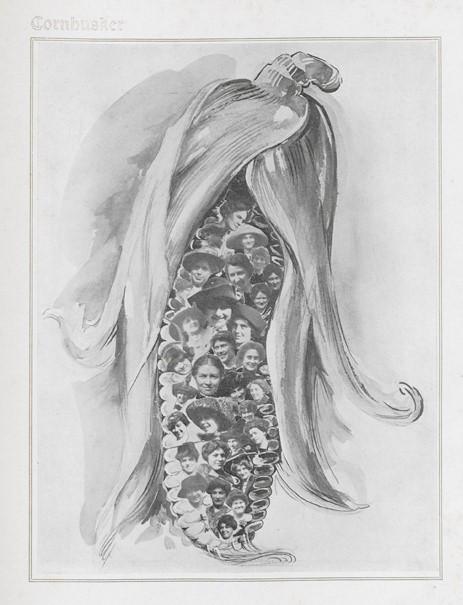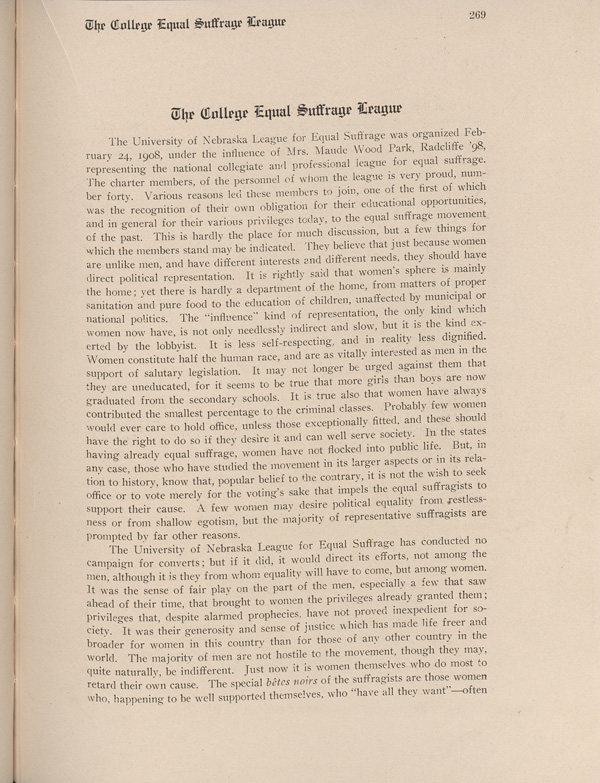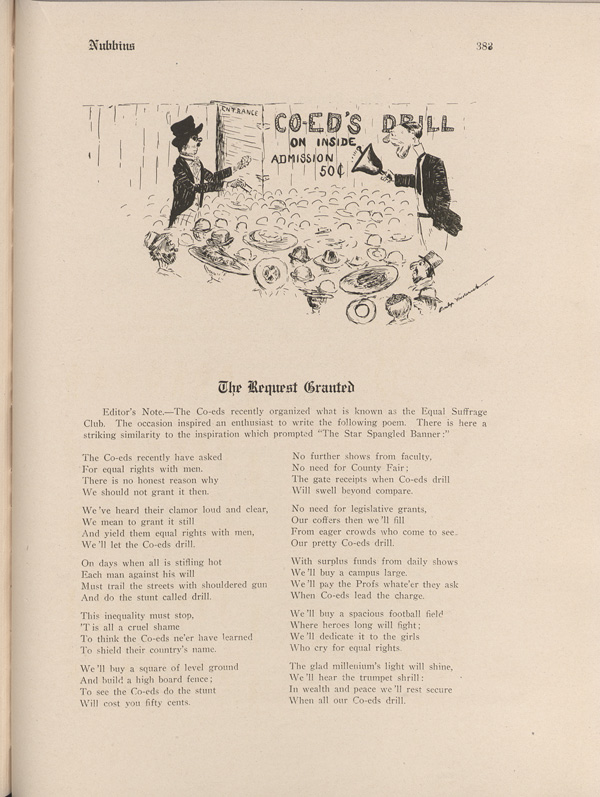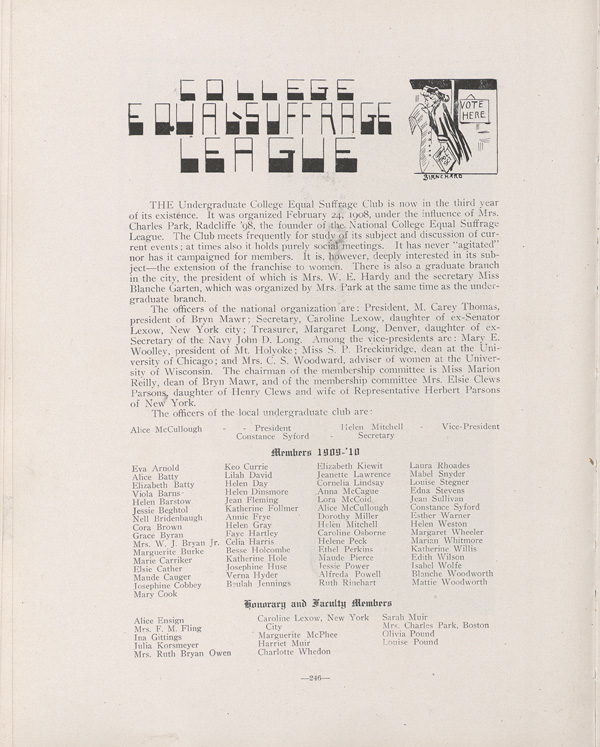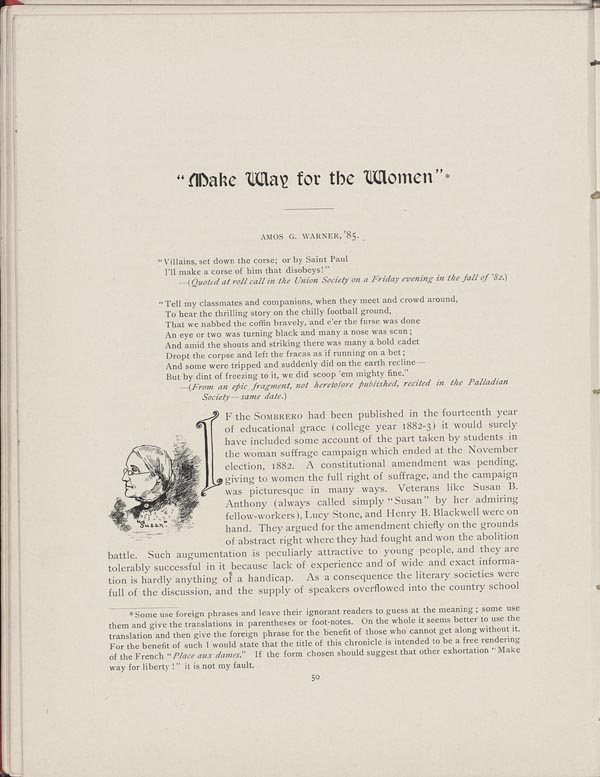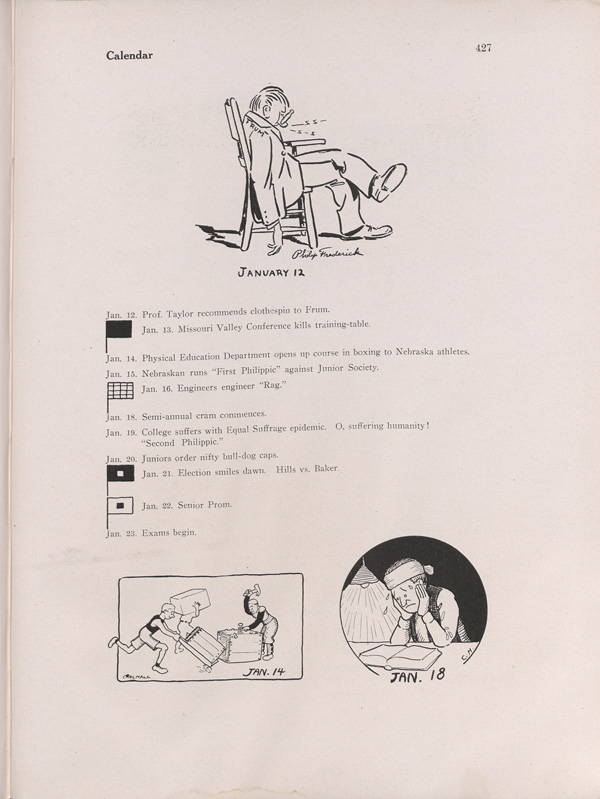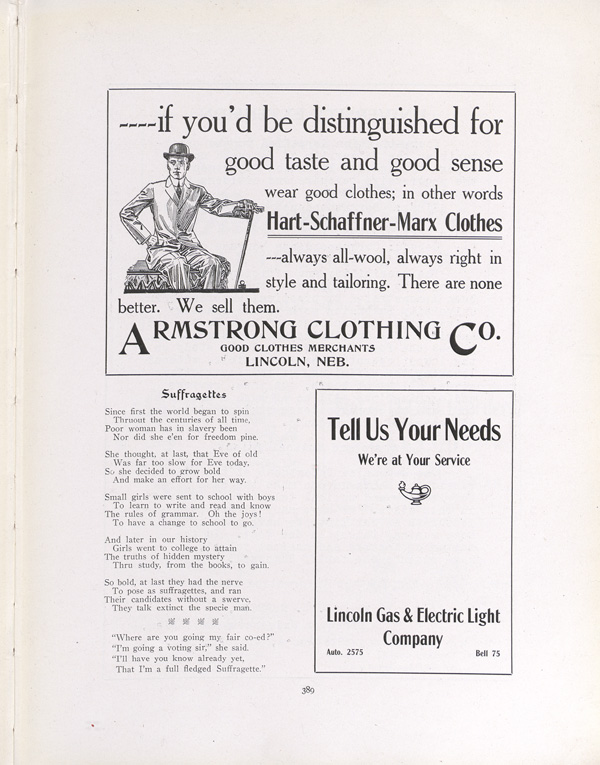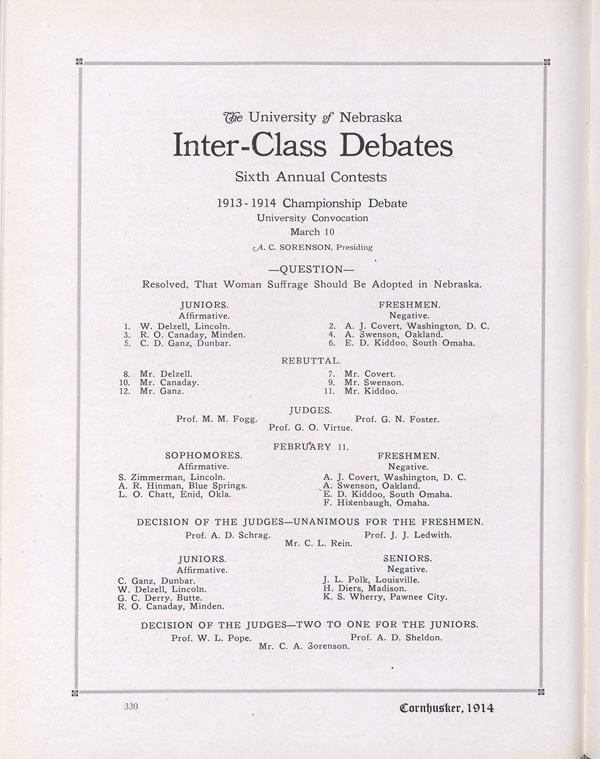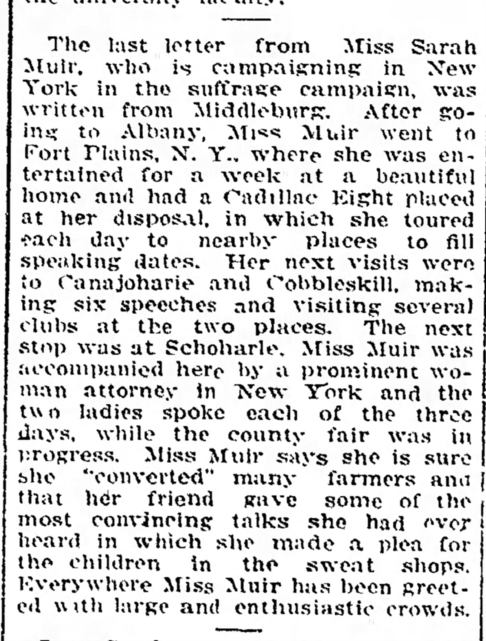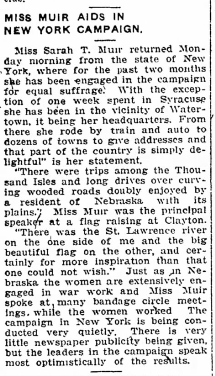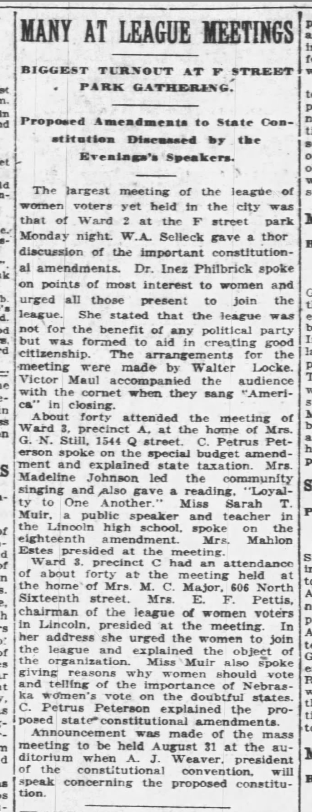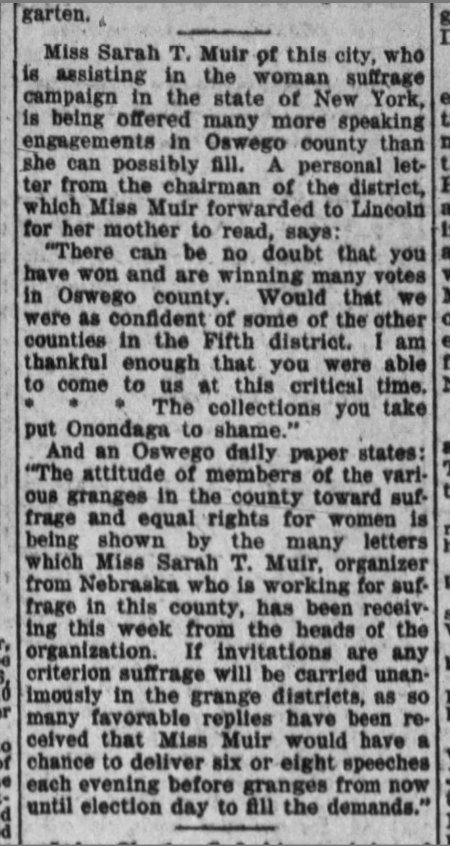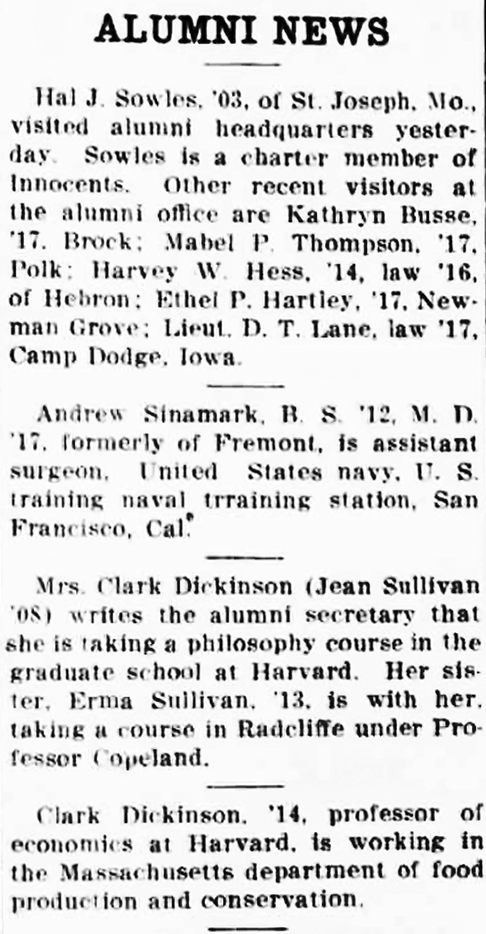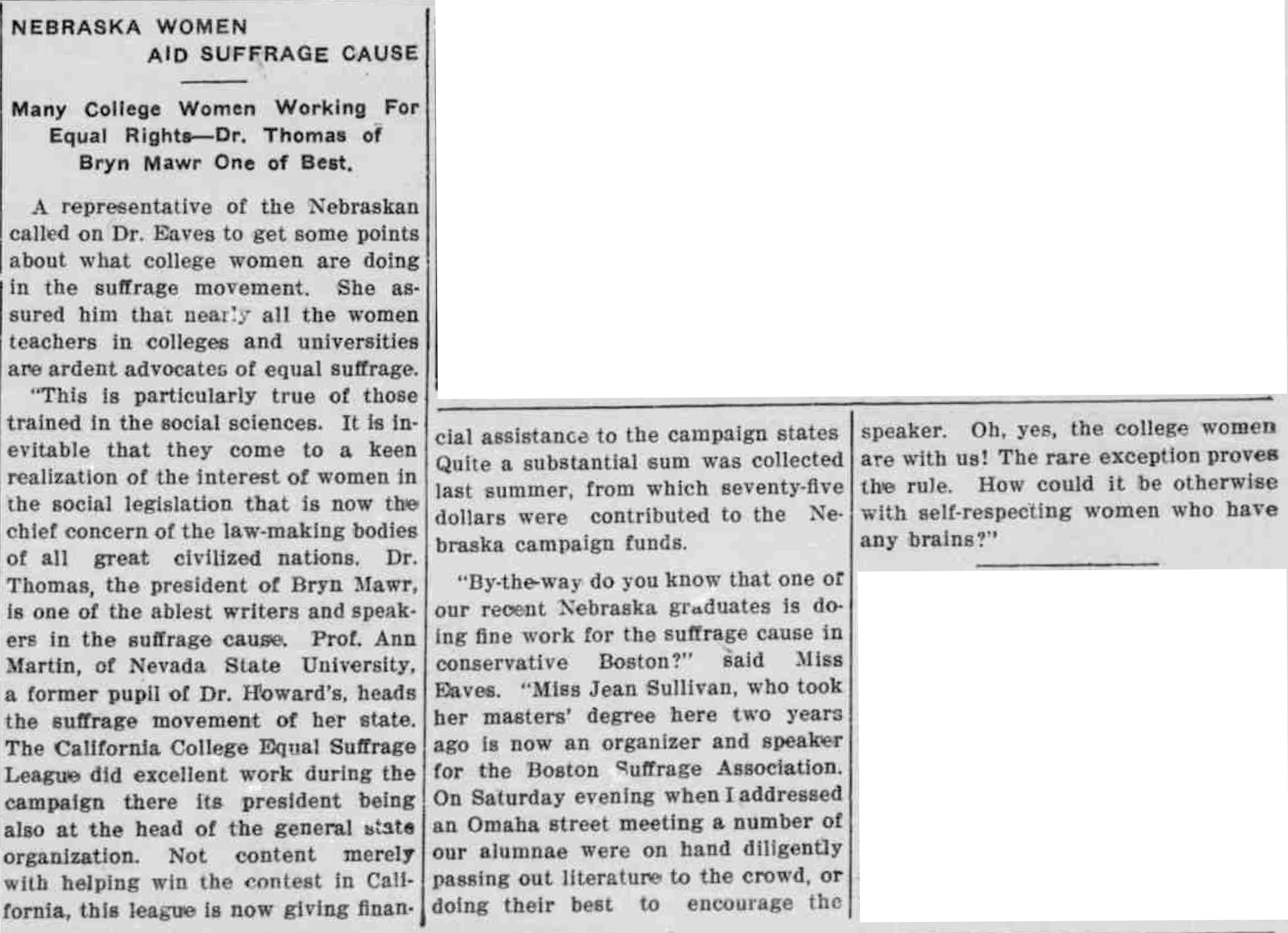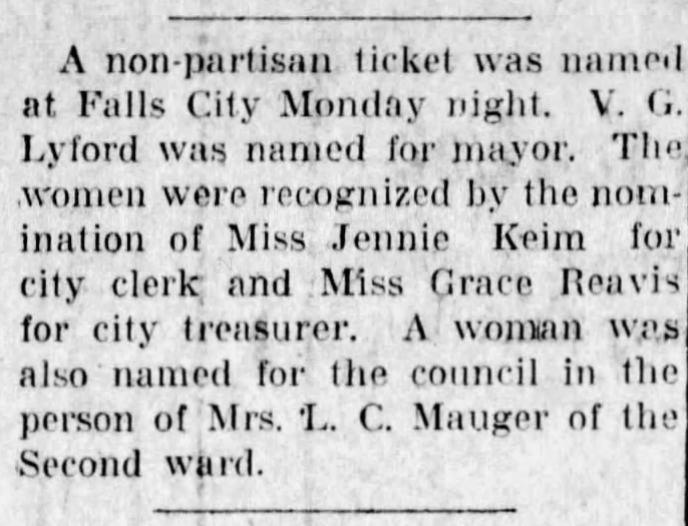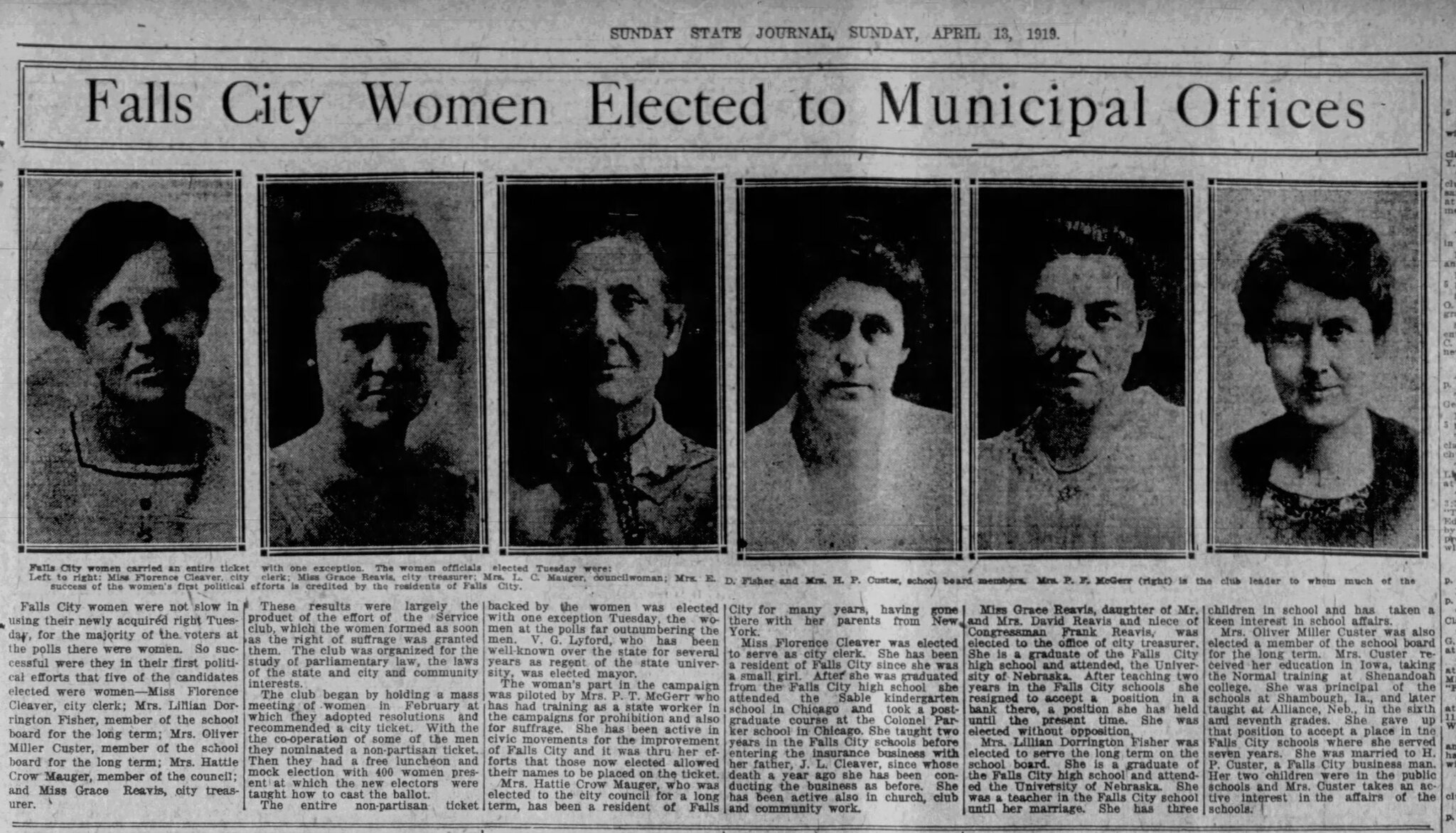Votes for Women:
Student Perspectives
This online exhibit showcases the perspectives of UNL students during the women’s suffrage movement. Through yearbook entries and newspaper articles, a clear picture of student opinions and involvement in the suffrage movement can be seen. Both supporting and opposing perspectives on the women’s suffrage movement are included to provide a better understanding. In addition to student perspectives on women’s suffrage, the accomplishments of student suffragists post-graduation are included.
A timeline of major events within Nebraska’s suffrage movement is provided to contextualize student experiences and perspectives.
The Nebraska Suffrage Movement
In 1917, Nebraska made history by granting women the right to vote in municipal elections. In order for this to be achieved, Nebraskans had to fight for suffrage for nearly seventy years. Nebraska’s rich involvement in the nationwide fight for women’s right to vote is noteworthy and deserving of recognition.
The year 1856 is commonly regarded as the beginning of the suffrage movement in Nebraska. Amelia Bloomer traveled to Nebraska and delivered a speech to the Nebraska Territorial House of Representatives, calling for women to be granted the right to vote. Even though Bloomer’s argument failed to win equal suffrage, this event sparked a movement consisting of women from various backgrounds coming together to press for the right to vote.
College students were among those who came together to fight for women’s suffrage. College campuses tended to be hotspots of suffrage activism as students were already familiar with co-ed environments where women’s rights were slowly progressing. Due to this, college students provide an interesting perspective on the suffrage movement. Student thoughts on and involvement in the suffrage movement can be seen through newspaper articles and yearbook entries.
Cornhusker Yearbook, 1913
Although UNL had an active Equal Suffrage League, student suffragists still had their fair share of criticism from anti-suffragist students. Along with an increase of pro-suffrage articles in the yearbooks, came jokes and arguments made against suffrage. However, despite their opposition, UNL suffragists continued to fight for the right to vote, and, in the end, they won.
In 1917, UNL suffragists reaped the benefits of their hard work and gained the right to vote in municipal elections. Then, three years later, America as a nation was able to celebrate the ratifying of the nineteenth amendment August 18, 1920, which awarded women the right to vote in all elections. Nebraskan suffragists made a significant contribution to the nationwide suffrage movement.
Nebraska Suffrage Timeline
This timeline charts major events that occurred within the suffrage movement in Nebraska from 1855 to 1920.
Student Involvement
College campuses tended to have a fair amount of student suffragists due to students’ exposure to co-ed environments where women were already experiencing progress in higher education. UNL was not an exception.
UNL student suffragists were active in the fight for women’s right to vote in a variety of ways. Many attended local speeches and conventions, and some debated suffrage with their classmates on the debate team.
Eventually, in February 1908, The Equal Suffrage League was created at the University of Nebraska to provide student suffragists with an easier way to stay involved.
The Equal Suffrage League offered young student suffragists the opportunity to meet with like-minded individuals and keep up-to-date with events related to equal suffrage. Additionally, the organization provided a space for suffragists to educate themselves and discuss issues relating to suffrage.
With the increasing presence of student suffragists on campus, many students who opposed suffrage became more vocal. Anti-suffragist rhetoric can also be found in the yearbooks following the creation of The Equal Suffrage League.
The Equal Suffrage League
There are now six millions of self-supporting women in this country engaged in industries and professions, and they deserve voice in making the laws under which they have to work.
The Equal Suffrage League at UNL offered student suffragists the opportunity to be involved in the fight for women’s right to vote.
Various yearbook entries following the creation of the league detail the mission of the group. They express that members felt the need to support the suffrage movement, as women attributed their privilege of obtaining a higher education to the suffrage movements of the past.
Yearbook entries also indicate the group did not actively recruit new members. Despite never recruiting new members, the league grew from a charter membership of 40 to an average of 70+ members in the following years.
Links to full transcripts of featured pages:
University of Nebraska Yearbooks, 1908, pp. 269
University of Nebraska Yearbooks, 1908, pp. 270
University of Nebraska Yearbooks, 1908, pp. 383
University of Nebraska Yearbooks, 1910, pp. 246
The Discussion of Suffrage in UNL Yearbooks
“Where are you going my fair co-ed?”
“I’m going a voting sir,” she said,
“I’ll have you know already yet,
That I’m a full fledged Suffragette.”
After the creation of the Equal Suffrage League, student opinions on suffrage were more frequently included in the yearbooks.
Many of these opinions were not positive. Some expressed that the college suffered from an “Equal Suffrage epidemic.”
Others said that suffragists “talk extinct of the specie man.” Anti-suffragist rhetoric frequently focused on the fear of women rising above men, rather than women simply wanting to be equal to men.
Additionally, the yearbooks indicate that in 1914, the university held an inter-class debate on the question of whether or not Nebraska should grant women suffrage.
Links to full transcripts of featured pages:
University of Nebraska Yearbooks, 1909, pp. 427
University of Nebraska Yearbooks, 1911, pp. 389
University of Nebraska Yearbooks, 1914, pp. 330
There’s no greater evil around us,
Than the curse of a suffragette.
The topic of suffrage was frequently presented in yearbooks in the form of poetry or short stories.
The yearbook pages included here showcase three of these examples, where suffrage is discussed through poetry.
Although it is quite small, the last image mentions an event on April 4, 1919, titled “The University Players Ibsen’s ‘The Doll’s House’ Tragedy that Portrays Women’s Struggle For Human Rights.”
Links to full transcripts of featured pages:
University of Nebraska Yearbooks, 1914, pp. 395
University of Nebraska Yearbooks, 1914, pp. 402
University of Nebraska Yearbooks, 1916, pp. 438
University of Nebraska Yearbooks, 1919, pp. 295
Achievements of UNL Student Suffragists
After graduation, UNL suffragists went on to accomplish even more within the suffrage movement. Some traveled and relocated to different states and contributed to their suffrage movements; while others stayed in Nebraska and helped further the state’s fight for women’s right to vote. The accomplishments of these UNL alumni can be traced through various newspaper articles.
Sarah Muir

From Suffragist to State Representative
Sarah Muir earned BA and MA degrees from the University of Nebraska-Lincoln and made significant contributions to the suffrage movement. While at the University, she was involved in the College Equal Suffrage League from 1908 to 1911.
Muir went on to participate in the fight for suffrage in New York as well. Newspaper articles detail her extensive travels, where she gave numerous speeches advocating for women’s suffrage. After winning the right to vote, she continued working for women’s rights in the League of Women Voters. Muir campaigned to be the state representative of Nebraska’s 36th district. Elected in 1925 and again in 1933, she was the first woman to serve as a Representative in the Nebraska Legislature.
Jean Sullivan

Fighting for Suffrage Beyond Nebraska
Jean Sullivan was born and raised in Broken Bow, Nebraska. She enrolled at the University of Nebraska in 1906. In 1908 she joined The College Equal Suffrage League, during the first year of its creation, and continued her involvement in the league until she graduated in June of that year. After teaching high school for a few years, Sullivan returned to the University and earned her MA in sociology in 1913.
Following graduation from the University of Nebraska, Sullivan continued her involvement in the suffrage movement in Boston, Massachusetts. Newspaper articles detail Sullivan’s work as an organizer and speaker for the Boston Suffrage Association upon relocating there to attend Harvard.
Grace Reavis
Grace Reavis attended the University of Nebraska in 1912 and 1913. Prior to college, she attended school in Falls City, Nebraska.

Former UNL Student Takes Office
The above portrait from the 1912 Cornhusker Yearbook shows Grace Reavis as a student. Not long after studying at the University, Grace Reavis made history by becoming the Falls City treasurer in 1919. This was shortly after women were granted municipal suffrage in Nebraska. With this newfound right, many women, including Reavis, ran for offices in Falls City knowing they had a better chance of winning with the influx of woman voters. Five women were elected.
Bibliography
The Beatrice Daily Express. “A Non-Partisan Ticket Was Named at Falls City.” March 12, 1919.
Bloomberg, Kristin Mapel. “Cultural Critique and Consciousness Raising: Clara Bewick Colby’s Woman’s Tribune and Late-Nineteenth-Century Radical Feminism.” Women in Print: Essays on the Print Culture of American Women from the Nineteenth and Twentieth Centuries, edited by James P. Danky et al., pp. 27-63. University of Wisconsin Press.
Bloomberg, Kristin Mapel. “‘Striving for Equal Rights for All’: Woman Suffrage in Nebraska, 1855-1882.” Nebraska History 90 (2009): pp. 84-103. https://history.nebraska.gov/sites/history.nebraska.gov/files/doc/publications/NH2009EqualRights.pdf.
Bloomer, D.C. The Life and Writings of Amelia Bloomer. Arena Publishing Company, 1895. https://archive.org/details/lifeandwritingso028876mbp/page/n31/mode/2up.
The Cornhusker. Lincoln, Neb.: University of Nebraska, 1907. https://yearbooks.unl.edu/yearbook.php?year=1907,466#page/1/mode/transcription
The Cornhusker. Lincoln, Neb.: University of Nebraska, 1908. https://yearbooks.unl.edu/yearbook.php?year=1908,432#page/1/mode/transcription
The Cornhusker. Lincoln, Neb.: University of Nebraska, 1910. https://yearbooks.unl.edu/yearbook.php?year=1910,464#page/1/mode/transcription
The Cornhusker. Lincoln, Neb.: University of Nebraska, 1913. https://yearbooks.unl.edu/yearbook.php?year=1913,521#page/1/mode/transcription
The Cornhusker. Lincoln, Neb.: University of Nebraska, 1914. https://yearbooks.unl.edu/yearbook.php?year=1914,514#page/1/mode/transcription
The Cornhusker. Lincoln, Neb.: University of Nebraska, 1916. https://yearbooks.unl.edu/yearbook.php?year=1916,566#page/1/mode/transcription
The Cornhusker. Lincoln, Neb.: University of Nebraska, 1919. https://yearbooks.unl.edu/yearbook.php?year=1919,522#page/1/mode/transcription
Coulter, Thomas Chalmer. “A History of Woman Suffrage in Nebraska, 1856-1920.” Ph.D. dissertation. Ohio State University, 1967.
The Daily Nebraskan. “Alumni News.” October 24, 1917.
The Daily Nebraskan. “Nebraska Women Aid Suffrage Cause: Many College Women Working for Equal Rights-Dr. Thomas of Bryn Mawr One of the Best.” October 22, 1914.
Heider, Carmen. “Conceptions of the Nebraska Voter in 1882: Paradoxes and Complexities Among Women.” Great Plains Quarterly Vol. 17, No. 2, Spring 1997, pp. 131-42.
Hickman, Laura McKee. “Thou Shalt Not Vote: The Struggle for Woman’s Suffrage in Nebraska.” MA thesis. University of Nebraska-Omaha. 1997. https://digitalcommons.unomaha.edu/studentwork/2226.
The Lincoln Journal Star. “Hold A Political Meeting.” July 13, 1922.
The Lincoln Journal Star. “Miss Muir Aids in New York Campaign.” September 4, 1917.
The Lincoln Journal Star. “The Last Letter From Miss Sarah Muir.” September 27, 1915.
Nebraska State Journal. “Falls City Women Elected to Municipal Offices.” April 13, 1919.
Radke-Moss, Andrea G. Bright Epoch: Women and Coeducation in the American West. University of Nebraska Press, 2008. JSTOR, www.jstor.org/stable/j.ctt1dgn512.
Acknowledgements
University of Nebraska-Lincoln undergraduate student Alexis Thomas created this exhibit as part of the summer 2020 Schmidt Family Libraries Internship.

